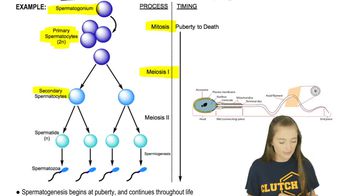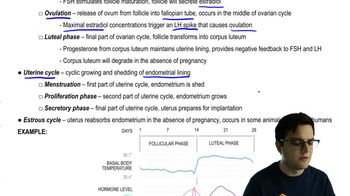Table of contents
- 1. Introduction to Biology2h 40m
- 2. Chemistry3h 40m
- 3. Water1h 26m
- 4. Biomolecules2h 23m
- 5. Cell Components2h 26m
- 6. The Membrane2h 31m
- 7. Energy and Metabolism2h 0m
- 8. Respiration2h 40m
- 9. Photosynthesis2h 49m
- 10. Cell Signaling59m
- 11. Cell Division2h 47m
- 12. Meiosis2h 0m
- 13. Mendelian Genetics4h 41m
- Introduction to Mendel's Experiments7m
- Genotype vs. Phenotype17m
- Punnett Squares13m
- Mendel's Experiments26m
- Mendel's Laws18m
- Monohybrid Crosses16m
- Test Crosses14m
- Dihybrid Crosses20m
- Punnett Square Probability26m
- Incomplete Dominance vs. Codominance20m
- Epistasis7m
- Non-Mendelian Genetics12m
- Pedigrees6m
- Autosomal Inheritance21m
- Sex-Linked Inheritance43m
- X-Inactivation9m
- 14. DNA Synthesis2h 27m
- 15. Gene Expression3h 20m
- 16. Regulation of Expression3h 31m
- Introduction to Regulation of Gene Expression13m
- Prokaryotic Gene Regulation via Operons27m
- The Lac Operon21m
- Glucose's Impact on Lac Operon25m
- The Trp Operon20m
- Review of the Lac Operon & Trp Operon11m
- Introduction to Eukaryotic Gene Regulation9m
- Eukaryotic Chromatin Modifications16m
- Eukaryotic Transcriptional Control22m
- Eukaryotic Post-Transcriptional Regulation28m
- Eukaryotic Post-Translational Regulation13m
- 17. Viruses37m
- 18. Biotechnology2h 58m
- 19. Genomics17m
- 20. Development1h 5m
- 21. Evolution3h 1m
- 22. Evolution of Populations3h 52m
- 23. Speciation1h 37m
- 24. History of Life on Earth2h 6m
- 25. Phylogeny2h 31m
- 26. Prokaryotes4h 59m
- 27. Protists1h 12m
- 28. Plants1h 22m
- 29. Fungi36m
- 30. Overview of Animals34m
- 31. Invertebrates1h 2m
- 32. Vertebrates50m
- 33. Plant Anatomy1h 3m
- 34. Vascular Plant Transport2m
- 35. Soil37m
- 36. Plant Reproduction47m
- 37. Plant Sensation and Response1h 9m
- 38. Animal Form and Function1h 19m
- 39. Digestive System10m
- 40. Circulatory System1h 57m
- 41. Immune System1h 12m
- 42. Osmoregulation and Excretion50m
- 43. Endocrine System4m
- 44. Animal Reproduction2m
- 45. Nervous System55m
- 46. Sensory Systems46m
- 47. Muscle Systems23m
- 48. Ecology3h 11m
- Introduction to Ecology20m
- Biogeography14m
- Earth's Climate Patterns50m
- Introduction to Terrestrial Biomes10m
- Terrestrial Biomes: Near Equator13m
- Terrestrial Biomes: Temperate Regions10m
- Terrestrial Biomes: Northern Regions15m
- Introduction to Aquatic Biomes27m
- Freshwater Aquatic Biomes14m
- Marine Aquatic Biomes13m
- 49. Animal Behavior28m
- 50. Population Ecology3h 41m
- Introduction to Population Ecology28m
- Population Sampling Methods23m
- Life History12m
- Population Demography17m
- Factors Limiting Population Growth14m
- Introduction to Population Growth Models22m
- Linear Population Growth6m
- Exponential Population Growth29m
- Logistic Population Growth32m
- r/K Selection10m
- The Human Population22m
- 51. Community Ecology2h 46m
- Introduction to Community Ecology2m
- Introduction to Community Interactions9m
- Community Interactions: Competition (-/-)38m
- Community Interactions: Exploitation (+/-)23m
- Community Interactions: Mutualism (+/+) & Commensalism (+/0)9m
- Community Structure35m
- Community Dynamics26m
- Geographic Impact on Communities21m
- 52. Ecosystems2h 36m
- 53. Conservation Biology24m
44. Animal Reproduction
Animal Reproduction
Problem 13a
Textbook Question
A woman had several miscarriages. Her doctor suspected that a hormonal insufficiency was causing the lining of the uterus to break down, as it does during menstruation, terminating her pregnancies. Treatment with which of the following might help her remain pregnant? a. oxytocin b. follicle-stimulating hormone c. luteinizing hormone d. prolactin
 Verified step by step guidance
Verified step by step guidance1
Identify the hormone responsible for maintaining the uterine lining during pregnancy. This hormone prevents the lining from breaking down, which is crucial for sustaining a pregnancy.
Understand the role of oxytocin, which primarily triggers labor and milk ejection, and is not directly involved in maintaining the uterine lining.
Consider the function of follicle-stimulating hormone (FSH) and luteinizing hormone (LH), which are primarily involved in the regulation of the reproductive processes such as the development of eggs and the stimulation of ovaries, but not in maintaining pregnancy after conception.
Examine the role of prolactin, which is known for its function in milk production and also has some influence on other reproductive functions, but is not the primary hormone responsible for maintaining the uterine lining during pregnancy.
Conclude that the hormone most likely to help maintain the uterine lining and prevent miscarriages by sustaining the pregnancy environment is not explicitly listed among the options provided, but understanding the roles of these hormones can guide towards effective treatment options.
Recommended similar problem, with video answer:
 Verified Solution
Verified SolutionThis video solution was recommended by our tutors as helpful for the problem above
Video duration:
1mPlay a video:
Was this helpful?
Key Concepts
Here are the essential concepts you must grasp in order to answer the question correctly.
Hormonal Regulation of Menstruation
The menstrual cycle is regulated by a complex interplay of hormones, including estrogen and progesterone. These hormones prepare the uterine lining for potential implantation of an embryo. If hormonal levels are insufficient, the lining may break down prematurely, leading to miscarriage. Understanding this regulation is crucial for addressing issues related to pregnancy maintenance.
Recommended video:
Guided course

Plant Hormones and Senescence
Progesterone's Role in Pregnancy
Progesterone is a key hormone produced by the ovaries after ovulation, essential for maintaining the uterine lining during early pregnancy. It prevents the uterus from contracting and supports the implantation of a fertilized egg. A deficiency in progesterone can lead to miscarriage, making it a critical focus in treating women with recurrent pregnancy loss.
Recommended video:
Guided course

Pregnancy and Birth
Hormonal Treatments for Pregnancy Maintenance
Hormonal treatments, such as progesterone supplementation, are often used to support women with hormonal insufficiencies during early pregnancy. These treatments aim to stabilize the uterine lining and reduce the risk of miscarriage. Understanding which hormones are involved and their specific roles helps in selecting appropriate therapies for women experiencing pregnancy complications.
Recommended video:
Guided course

Pregnancy and Birth

 5:44m
5:44mWatch next
Master Sexual and Asexual Reproduction with a bite sized video explanation from Jason Amores Sumpter
Start learningRelated Videos
Related Practice


































































